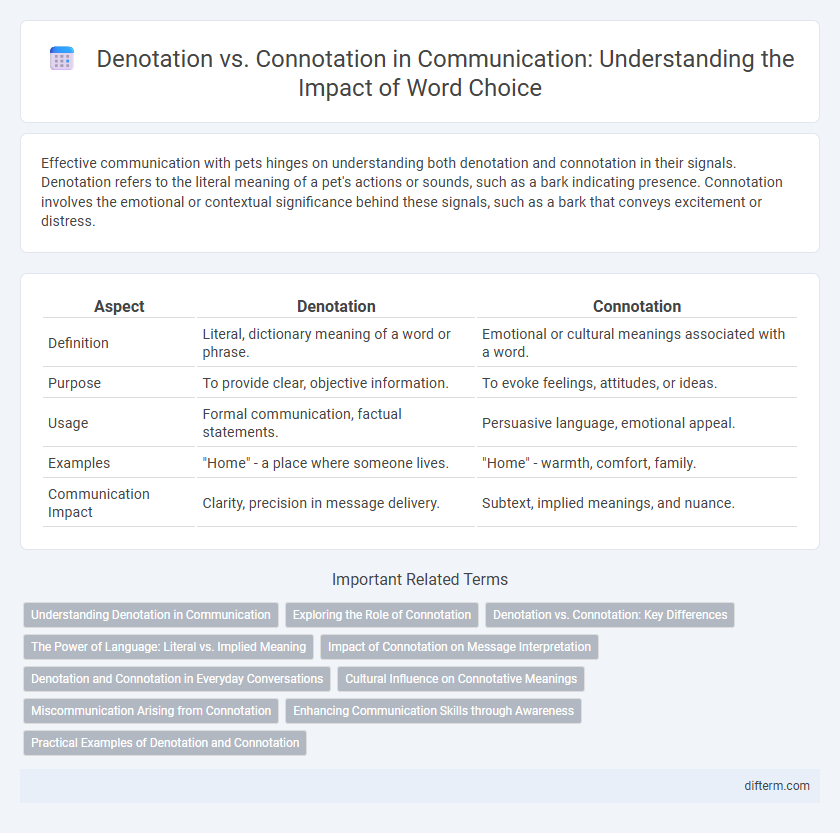Effective communication with pets hinges on understanding both denotation and connotation in their signals. Denotation refers to the literal meaning of a pet's actions or sounds, such as a bark indicating presence. Connotation involves the emotional or contextual significance behind these signals, such as a bark that conveys excitement or distress.
Table of Comparison
| Aspect | Denotation | Connotation |
|---|---|---|
| Definition | Literal, dictionary meaning of a word or phrase. | Emotional or cultural meanings associated with a word. |
| Purpose | To provide clear, objective information. | To evoke feelings, attitudes, or ideas. |
| Usage | Formal communication, factual statements. | Persuasive language, emotional appeal. |
| Examples | "Home" - a place where someone lives. | "Home" - warmth, comfort, family. |
| Communication Impact | Clarity, precision in message delivery. | Subtext, implied meanings, and nuance. |
Understanding Denotation in Communication
Understanding denotation in communication involves recognizing the explicit, literal meaning of words or symbols, which provides a clear and objective basis for conveying messages. Denotation serves as the fundamental building block for effective communication by minimizing ambiguity and ensuring mutual comprehension among participants. Precise use of denotative language enhances clarity, supports accurate information transfer, and reduces misunderstandings in diverse communicative contexts.
Exploring the Role of Connotation
Connotation shapes communication by adding emotional and cultural layers beyond the literal meaning of words, influencing audience perception and response. It plays a crucial role in rhetoric, branding, and interpersonal exchanges by subtly guiding interpretations and evoking specific feelings. Understanding connotation enables effective message framing, ensuring that communication resonates with targeted audiences on a deeper, more impactful level.
Denotation vs. Connotation: Key Differences
Denotation refers to the literal, dictionary definition of a word without emotional or cultural associations, while connotation encompasses the implied or emotional meanings linked to a word based on personal or societal experiences. Understanding the difference between denotation and connotation is essential in communication to avoid misinterpretations and ensure message clarity. Effective communicators analyze both denotative and connotative meanings to tailor messages for diverse audiences and contexts.
The Power of Language: Literal vs. Implied Meaning
Denotation refers to the literal, dictionary definition of a word, providing clear and unambiguous communication. Connotation involves the implied or emotional meaning associated with a word, which can influence perception and interpretation beyond its explicit definition. Understanding the subtle balance between denotation and connotation enhances effective communication and minimizes misunderstandings in language use.
Impact of Connotation on Message Interpretation
Connotation significantly shapes how messages are interpreted by imbuing words with cultural and emotional nuances beyond their denotative meanings. This layered meaning can influence audience perception, potentially altering the intended impact of communication. Understanding connotation is essential for effective messaging, as it guides the emotional and psychological response of recipients.
Denotation and Connotation in Everyday Conversations
Denotation refers to the literal, dictionary definition of a word, providing clarity in everyday conversations by establishing a common understanding. Connotation involves the emotional or cultural meanings associated with a word, influencing tone and interpersonal dynamics during communication. Recognizing both denotation and connotation enhances effective dialogue, preventing misunderstandings and enriching the exchange of ideas.
Cultural Influence on Connotative Meanings
Cultural influence shapes connotative meanings by embedding symbols, gestures, and language with unique societal values and emotions beyond their denotative definitions. For example, the color white signifies purity in Western cultures but represents mourning in some Eastern cultures, illustrating how context alters interpretation. Understanding these cultural nuances is essential for effective cross-cultural communication and preventing misinterpretations.
Miscommunication Arising from Connotation
Miscommunication often arises from the connotation of words, as individuals may attach different emotional or cultural meanings beyond the denotative definition. These subjective interpretations can lead to misunderstandings, especially in cross-cultural or diverse communication settings. Clarifying intended meaning by addressing both denotation and connotation reduces ambiguity and enhances effective information exchange.
Enhancing Communication Skills through Awareness
Understanding the denotation and connotation of words improves communication effectiveness by clarifying literal meanings versus emotional or cultural associations. Awareness of these distinctions helps avoid misunderstandings and creates more persuasive, empathetic messages tailored to diverse audiences. Developing this skill enhances interpersonal relationships and professional interactions through nuanced expression and active listening.
Practical Examples of Denotation and Connotation
In communication, denotation refers to the literal, dictionary meaning of a word, such as "snake" meaning a legless reptile, while connotation involves the emotional or cultural associations, often negative, like deceit or danger. For example, the word "home" denotatively means a place where one lives, but connotatively it evokes warmth, safety, and family. These distinctions influence message interpretation, making it crucial to consider both denotation and connotation in effective communication.
denotation vs connotation Infographic

 difterm.com
difterm.com